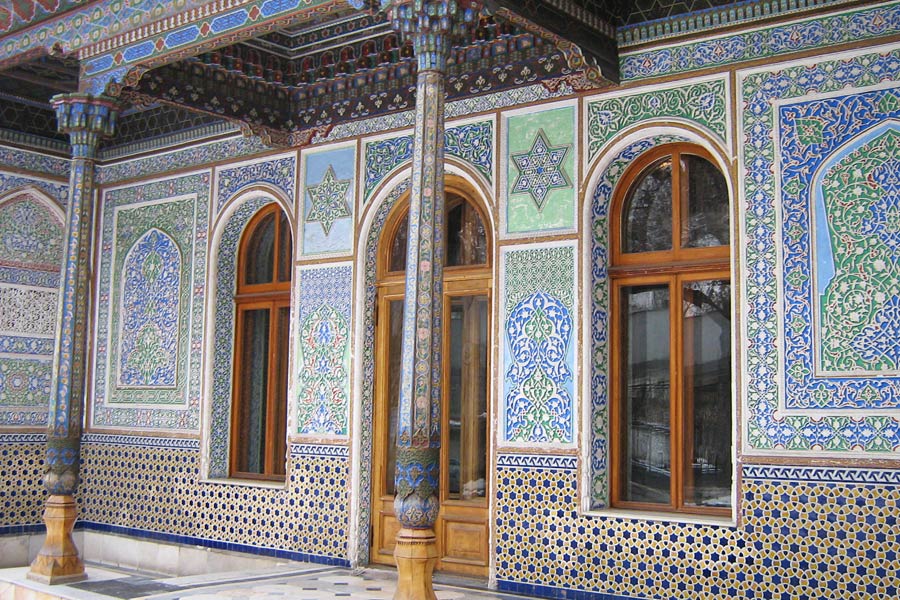The State Museum of History of Uzbekistan contains more than 250,000 exhibits, including the most valuable numismatic, archeological and ethnographical relics, which tell about the culture and traditions of the country’s people, the formation and development of the state system, and the evolution of the ethnic nature of the Uzbek people.
Of great interest is the collection of coins from antique states, once situated in the territory of modern Uzbekistan. These are the coins of the Hellenic state of Seleucids (3rd century BC), Graeco-Bactrian drachmas of the 3rd-2nd centuries BC, and coins of Kushan Kingdom that existed from the 1st century BC to the 2nd century AD. Sogdian, Bucharan, Khoresmiam coins dating back to the first centuries AD are displayed next to the coins from Parthia and Sassanid Kingdom, states of Yuezhi and Chang’an, and Chinese coins of Tan dynasty. All of them vividly testify to strong trade connections between East and West on the crossroads of the Great Silk Road caravan trails.
In the State Museum of History of Uzbekistan, there are Zoroastrian ossuaries, Sogdian and Baktrian wall paintings, Buddhist sculptures, Halchayan ceramics and artifacts of the Temurid dynasty, which tell the stories of the rich spiritual and material heritage of the Uzbek people. One section of the museum is devoted to the modern history of independent Uzbekistan.
State Museum of Temurids is located in the center of the Uzbek capital, in the building crowned with the huge blue dome reminiscent of the ancient domes of Samarkand. The interior of the museum is faced with marble; the cupola-shaped ceiling is ornamented and decorated in the finest traditions of the Uzbek art with gold leaf; the walls of the exhibit rooms are decorated with frescos in the style of oriental miniature paintings, which tell about the life of Amir Temur and historical periods of the country from the ancient times to the present. Exposition of the museum is devoted to one of the most significant periods in the history of Uzbekistan, the epoch of Temur and his descendants, the Temurids. Thousands of exhibits are connected with the name of Amir Temur: carved wooden columns of the 15th century, articles of clothing, weapons, and ancient manuscripts convey to visitors the flavor of Temurid’s epoch.

The State Fine Arts Museum is the oldest museum in Uzbekistan. In 1918, the collection of pieces of art that decorated the palace of great Duke Nikolay Konstantinovich, who lived in Tashkent, was nationalized. The collection includes paintings, drawings, and sculptures by western and Russian artists, decorative furniture, and objects made of crystal, porcelain, and bronze. At the beginning of the 1920s, some pieces of art were handed over to the museum from the Tretyakov Gallery, Hermitage, the Russian Museum and Pushkin Art Museum, as well as from the Moscow Rumiantsev Museum, which by that time, had been closed. Later, the museum collection was enriched by acquisitions from private donors.
Museum of Decorative and Applied Art is located in the building that before 1917 belonged to Polovtsev, an industrialist and connoisseur of traditional oriental architecture. The interior walls of the museum are decorated with ancient ganch carving and magnificent ornamental painting. The exposition of the museum offers the best examples of local folk crafts representing virtually all the regional schools and artistic trends of the 19th-20th centuries. Here one can see “blue ceramics” of Rishtan and Gurumsaray craftsmen, pottery made by Shakhrisabz, Khiva, Gijduvan, and Tashkent hereditary potters, or kulols. The special sections will tell the visitor about carpet weaving, hand embroidery and famous Bukharan gold embroidery. In some rooms, the shimmering of the patterns on copper and brass engraved articles rivals the glittering of gold and precious stones of national jewelry. Part of the museum is assigned for exhibiting handwoven articles and different items of clothing and headwear.

Karakalpak State Art Museum in Nukus is one of the most famous museums in Uzbekistan. It is named after its founder and first director, Igor Savitsky. The archeological exhibits of the museum tell about the intellectual wealth and culture of the ancient state Khorezm, then the cradle of Zoroastrian doctrines, about trade relations of the Khoresmians with the antique world.
The museum has a large collection of unique medieval ceramics, national Karakalpak silver and cornelian jewelry, and traditional carpets. But what makes the museum known worldwide is the collection of Russian avant-garde art of the twentieth century, comparable only to the collection in the Russian Museum in St. Petersburg. In the halls of the Karakalpak State Art Museum, there are early works by A. Volkov and U. Tansykbayeva; the canvases by famous impressionists who lived in Uzbekistan P. Benkov and Z. Kovalevskaya; Russian avant-garde artists of the beginning of the 20th century P. Kuznetsov, A. Kuprin, N. Ulianov, and V. Rojdestvenskiy. Some of the masterpieces from the museum collection have been exhibited in Switzerland, France, and Italy.
Termez ArchAeological Museum first opened its doors in April 2002, when Termez was celebrating its 2,500th anniversary. This museum is the only one in its kind in the Central Asian region. The collection includes archaeological artifacts, numismatics, paintings, sculpture, photographs, household objects, etc. There are various exhibitions here of the Stone and Bronze Age, the Hellenic and Ancient Bactria period, Kushan’s culture of Northern Bactria, Northern Tokharistan in the early Middle Ages, and the age of Khanates. Thousands of exhibits tell about the centuries-old history of the region. The scientific library and the stores of the Termez Archaeological Museum hold more than 16,000 unique books, periodicals, and historical records. Among them are valuable manuscripts and lithographic publications in Arabic, Persian, and European languages.





